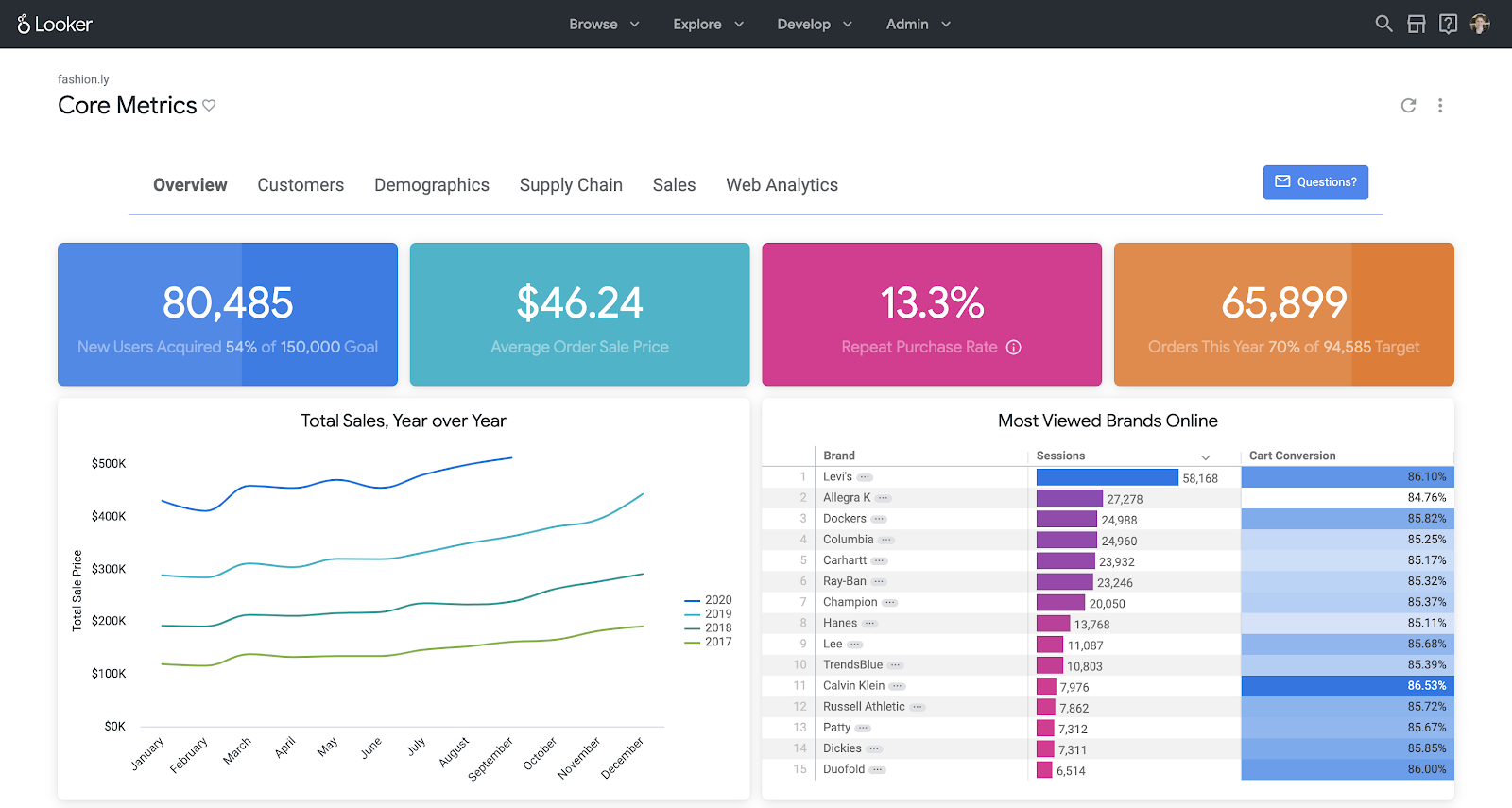Looker: Complete Buyer's Guide
Google's enterprise-grade business intelligence platform
Looker is Google's enterprise-grade business intelligence platform that transforms complex ecommerce data into actionable insights through its unique LookML modeling approach. Best for mid-market to enterprise retailers with dedicated data engineering teams who need sophisticated analytics capabilities across multiple data sources and channels.
Market Position & Maturity
Market Standing
Looker maintains a strong enterprise position in the business intelligence market, particularly following its acquisition by Google Cloud, which provides substantial backing and integration opportunities within the broader Google ecosystem [39][41].
Company Maturity
Google's investment in Looker demonstrates long-term commitment to the platform's development and market presence. This backing provides buyer confidence in the platform's continued evolution and support, particularly important for enterprise implementations requiring multi-year commitments [39][41].
Growth Trajectory
Customer growth patterns show strong retention among enterprise clients who successfully implement the platform, though adoption requires significant technical investment [58].
Industry Recognition
Industry recognition includes positioning in analyst reports, though specific rankings require verification. The platform's reputation centers on technical capabilities and enterprise-grade functionality rather than ease of use or broad market appeal [16].
Strategic Partnerships
Strategic partnerships within the Google Cloud ecosystem provide integration advantages and market positioning benefits. The platform's multi-cloud flexibility maintains competitive positioning while leveraging Google's infrastructure investments [39][41].
Longevity Assessment
Market maturity indicators suggest Looker has established itself as a viable long-term platform choice for organizations requiring sophisticated analytics capabilities. The Google acquisition provides stability and continued development resources, addressing buyer concerns about vendor longevity and platform evolution.
Proof of Capabilities
Customer Evidence
Lite e-Commerce achieved measurable operational improvements, reducing weekly reporting time from 8-10 hours to 2 hours while improving marketing ROI by 28% through better channel optimization [56]. Ocado Technology successfully scaled Looker across over 700 weekly active users, enabling self-serve insights that reduced dependency on centralized data teams [58]. Trendyol leveraged Looker's real-time processing capabilities during Black Friday for dynamic campaign adjustments, contributing to a 13% boost in conversions through personalization features [51][57]. Walmart demonstrates Looker's enterprise scalability, processing billions of transactions during Black Friday with zero downtime [44].
Quantified Outcomes
Quantified business impact includes 15% reduction in inventory holding costs and 28% improvement in marketing ROI across customer implementations [56][58].
Market Validation
Customer retention patterns show strong satisfaction among organizations that successfully implement Looker, though success correlates with adequate technical resources and proper implementation planning [58].
Reference Customers
Organizations like Ocado Technology demonstrate the platform's ability to scale across large user bases when properly implemented [58].
AI Technology
Looker's technical foundation centers on LookML (Looker Modeling Language), a proprietary approach that enables centralized definition of business metrics across organizations [39][41].
Architecture
The platform's multi-cloud architecture provides flexibility across BigQuery, Snowflake, Redshift, and Azure Synapse, enabling organizations to maintain their preferred data warehouse while gaining sophisticated analytics capabilities [39][41].
Primary Competitors
Primary competitors include Tableau, Power BI, and Qlik, though Looker's technical approach creates distinct market positioning [43][45].
Competitive Advantages
Competitive advantages include superior embedded analytics capabilities through comprehensive APIs that enable direct integration into ecommerce platforms [43][45]. Looker's LookML approach offers more reusable business logic compared to Power BI's DAX formulas, though requiring greater technical expertise [39][43].
Market Positioning
The platform competes on technical depth and integration capabilities rather than ease of use or broad market appeal.
Win/Loss Scenarios
Win scenarios favor Looker when organizations require sophisticated data modeling, embedded analytics, or consistent metric definitions across complex organizational structures [39][41]. Loss scenarios typically involve organizations prioritizing ease of use, immediate deployment, or visual storytelling over technical capabilities.
Key Features

Pros & Cons
Use Cases
Integrations
Pricing
Featured In Articles
Comprehensive analysis of Business Intelligence for Ecommerce for Ecommerce businesses and online retailers. Expert evaluation of features, pricing, and implementation.
How We Researched This Guide
About This Guide: This comprehensive analysis is based on extensive competitive intelligence and real-world implementation data from leading AI vendors. StayModern updates this guide quarterly to reflect market developments and vendor performance changes.
58+ verified sources per analysis including official documentation, customer reviews, analyst reports, and industry publications.
- • Vendor documentation & whitepapers
- • Customer testimonials & case studies
- • Third-party analyst assessments
- • Industry benchmarking reports
Standardized assessment framework across 8 key dimensions for objective comparison.
- • Technology capabilities & architecture
- • Market position & customer evidence
- • Implementation experience & support
- • Pricing value & competitive position
Research is refreshed every 90 days to capture market changes and new vendor capabilities.
- • New product releases & features
- • Market positioning changes
- • Customer feedback integration
- • Competitive landscape shifts
Every claim is source-linked with direct citations to original materials for verification.
- • Clickable citation links
- • Original source attribution
- • Date stamps for currency
- • Quality score validation
Analysis follows systematic research protocols with consistent evaluation frameworks.
- • Standardized assessment criteria
- • Multi-source verification process
- • Consistent evaluation methodology
- • Quality assurance protocols
Buyer-focused analysis with transparent methodology and factual accuracy commitment.
- • Objective comparative analysis
- • Transparent research methodology
- • Factual accuracy commitment
- • Continuous quality improvement
Quality Commitment: If you find any inaccuracies in our analysis on this page, please contact us at research@staymodern.ai. We're committed to maintaining the highest standards of research integrity and will investigate and correct any issues promptly.